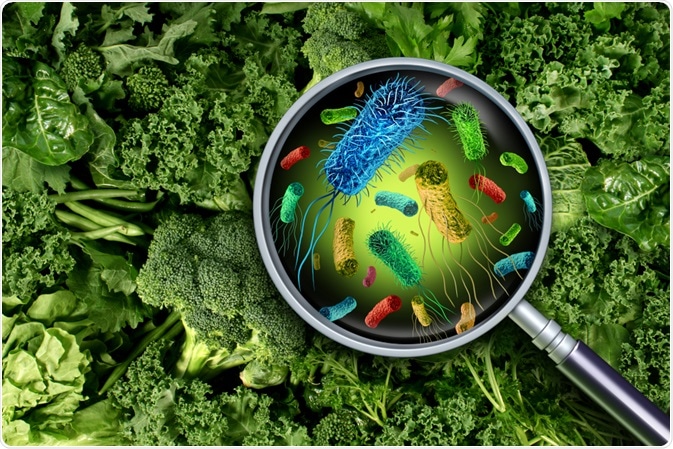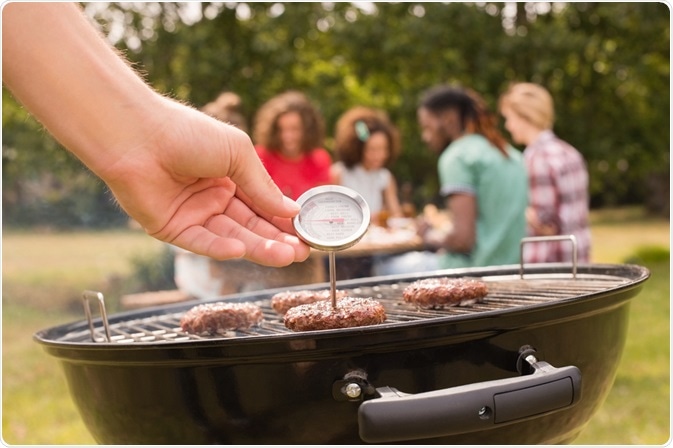Each year, around 420,000 million people die unnecessarily after contracting food-borne diseases from contaminated food.

Contaminated Food. Image Credit: Lightspring/Shutterstock.com
While the burden of food-borne diseases is carried disproportionately, with countries in the developing world suffering more from the consequences of contaminated food, it is a problem that significantly impacts all countries and socioeconomic classes. Roughly one in ten people become ill annually from food-borne diseases, which can cause many serious symptoms, from diarrhea to cancer.
Fortunately, the major routes to food contamination can be controlled, and strategies can be fairly successfully implemented to protect people from consuming contaminated food. The home kitchen can be a source of food contamination, with improper hand washing, cross-contamination, and improper storage and cooking of food acting as major routes to food-borne disease. Here, we detail the main ways food contamination can be avoided in the home kitchen.
Hand washing prevents food contamination
According to the Centers for Disease Control and Prevention (CDC), hand washing is one of the most important preventative techniques for protecting one’s self and their family from food poisoning when preparing food at home. Frequent and thorough handwashing with soap and water is an effective method of preventing germs from spreading from their source to foods and kitchen surfaces and utensils.
The CDC highlights several key times when handwashing is particularly important for stopping the spread of pathogens: before, during, and after preparing food of any kind; after touching eggs and raw poultry, meat, and seafood; before eating, after touching waste (such as throwing out the trash); after using chemicals to clean surfaces and counters; after touching or feeding pets; after coughing, sneezing, or blowing your nose.
Much research suggests that for handwashing to be effective, hands should be rubbed together with soap for 12 to 20 seconds before rinsing them and drying them thoroughly.
Avoiding cross-contamination of food products at home
Cross-contamination can occur fairly easily in the home kitchen. In most cases, cross-contamination at home happens when raw food with pathogens on it comes into contact with food that is cooked or ready-to-eat or with surfaces and utensils.
Raw food can carry harmful bacteria that are killed off through cooking. However, if raw food (such as meat, fish, and poultry) touches food that is already cooked or ready to eat, the bacteria introduced to these foods endures as cooking is not required. This means that harmful pathogens can be introduced to the human body once these foods are consumed. Similarly, when raw foods come into contact with surfaces and utensils, if they are not thoroughly cleaned before they are used with other foods, the pathogens can be transferred, contaminating the food.
To prevent cross-contamination at home, it is recommended that separate utensils and surfaces are used for cooked and raw food, utensils and surfaces should be thoroughly cleaned in-between cooking tasks, and hands are washed after touching raw meat, fish, and poultry.
Additionally, it is advised that care should be taken when purchasing and transporting food items. Raw foods should be packed separately from ready-to-eat food, as should chemical products. If you reuse shopping bags, the same ones should be used each time for raw and cooked foods. Finally, cotton bags are recommended when reusing bags as they can be machine washed in between shopping trips.
How to properly store food at home
Proper food storage is also an important aspect of preventing cross-contamination. Raw meat, poultry, and fish have the potential to drip onto other food items in the fridge, introducing pathogens to food that may be consumed raw. To prevent this, raw food should be kept at the bottom of the fridge, and food that may drip should be placed on a dish with a lip.
Additionally, raw food should be kept at adequately cold temperatures (in the fridge) and not left at ambient temperatures for long periods as this allows pathogens to proliferate.

Meat Thermometer. Image Credit: wavebreakmedia/Shutterstock.com
The importance of thoroughly cooking food
Finally, cooking presents an effective method of killing dangerous pathogens that may exist on raw meat, fish, and poultry. Therefore, cooking these items thoroughly is vital to ensuring the safety of food eaten at home. Cooking instructions should be followed carefully, and food should be checked for signs that it is thoroughly cooked and was heated to an adequate temperature before it is served.
Summary
While there are many routes to the contamination of food in the home kitchen, there are many simple and effective preventative methods to ensure that food prepared at home is safe to eat. Overall, it is key that raw meat, poultry, and fish are considered as a source of pathogens.
Therefore, washing hands after touching these food products, as well as thoroughly cleaning any utensils and surfaces it has come into contact with is key. Finally, the storage of these foods is important to prevent the dripping of pathogen-loaded liquids onto other food items.
-2.jpg)
Sources:
- Avoiding cross-contamination. Food Standards Agency. Available at: https://www.food.gov.uk/safety-hygiene/avoiding-cross-contamination
- Carrasco, E., Morales-Rueda, A. and García-Gimeno, R., 2012. Cross-contamination and recontamination by Salmonella in foods: A review. Food Research International, 45(2), pp.545-556. www.sciencedirect.com/science/article/abs/pii/S0963996911006260
- Food Safety in the Kitchen. Centers for Disease Control and Prevention. Available at: www.cdc.gov/foodsafety/communication/food-safety-in-the-kitchen.html
- Handwashing: A Healthy Habit in the Kitchen. Centers for Disease Control and Prevention. Available at: https://www.cdc.gov/handwashing/handwashing-kitchen.html
- Monk-Turner, E., Edwards, D., Broadstone, J., Hummel, R., Lewis, S. and Wilson, D., 2005. Another Look at Hand-Washing Behavior. Social Behavior and Personality: an international journal, 33(7), pp.629-634. www.ingentaconnect.com/content/sbp/sbp/2005/00000033/00000007/art00001
Further Reading
Last Updated: Jun 3, 2021